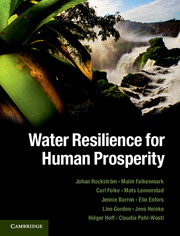Preface
Published online by Cambridge University Press: 05 August 2014
Summary
Why yet another book on water? Partial thinking and sectoral approaches have dominated resource and environmental management for too long, and this is also true for freshwater. Perspectives are rapidly changing, however, expanding on the conventional perception of freshwater as ‘blue water’ – a natural resource to be extracted from rivers and groundwater for households, industry, irrigation and economic production. Integrated water resource management (IWRM), although still predominantly concerned with the blue water branch of the water cycle, has extended the focus to interacting sectors in catchments. More recently, water vapour or ‘green water’ has increased focus in the policy arena on issues such as rainfed agriculture. The role of freshwater in ecosystem services, both terrestrial and aquatic, is now on the agenda, as well as work on their water trade-offs or in relation to water-related tipping points in dynamic landscapes. New approaches are emerging, such as adaptive water governance of landscapes and catchments.
The biosphere – the sphere of life – is the living part of the outermost layer of our rocky planet – the part of the Earth’s crust, oceans and atmosphere where life dwells. It is the global life-support system that integrates all living beings and their relationships. Life on Earth interacts in myriad ways with the chemistry of the atmosphere, the circulation of the oceans and the water cycle, including solid water in polar and permafrost regions, to form favourable conditions for life on Earth. People and societies are integrated parts of the biosphere, dependent on its functioning and life support.
- Type
- Chapter
- Information
- Water Resilience for Human Prosperity , pp. xv - xviPublisher: Cambridge University PressPrint publication year: 2014



